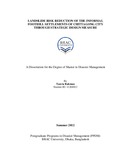Landslide risk reduction of the informal foothill settlements of Chittagong city through strategic design measure
Abstract
Globally Bangladesh is recognized as one of the most vulnerable countries to natural
calamities. Along with cyclones and floods; two most discussed and disastrous hazards of the country, landslides have caused the death of nearly 235 people in various informal settlements of Chittagong city and its adjacent urban centers since 1997. In Chittagong city, about 30 percent of the total population lives in the informal settlements where living environments are quite unsatisfactory and they are deprived of access to basic facilities. The rapid growth of urban population of Chittagong city is fuelled by migration of the rural poor to the city, drawn by perceived chances of finding cash employment in the industrial sector and pushed by the limited opportunities in rural areas. On arrival, many are unable to afford proper housing, so turn to live in informal settlements. Ineffective hill management policy at the national level and weak enforcement by the local authorities has created space for growing many informal settlements along landslide prone hill slopes and foothills in Chittagong city. However, there is no institutional arrangement for vulnerability assessment of those informal settlements to landslides. Few researches on landslide focus on hill cutting issues but are unable to explain the role of formal institutional arrangements for reducing vulnerability of the informal settlers. Neither national level landslide risk reduction organizations nor local level organizations and NGOs have planned and executed any proper structural and non-structural mitigation measure other than conventional stabilization (simple retaining walls) of hill toe and relocation respectively. Besides being more affected by landslides the informal settlers have less willingness to adapt risk reduction measures like relocation. Mostly land tenure conflict, trust, socio-economic status (education, income) and powerlessness inhibit these
populations in accepting new institutional arrangements. The growing distrust and
conflict has tightened pre-landslide institutional arrangements for reducing vulnerability.
However, there is usually no standard rule of thumb solution because formulation of
mitigation measure is often unique for each site and requires proper technical evolution of causative factors. This study explores different strategic design measures on the basis of assessment of risk, uncertainty, possible consequences, constructability, environmental impacts and costs. It suggests that, while proposing a specific measure, it is best to keep simple to match the physical characteristics of the hill and the availability of materials. The study makes an effort to contribute in the development of a comprehensive design solution to reduce landslide vulnerability that can be adapted to ensure the settlers immediate safety.

